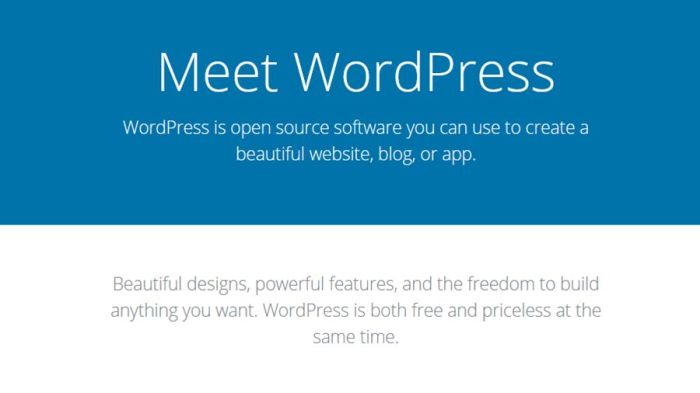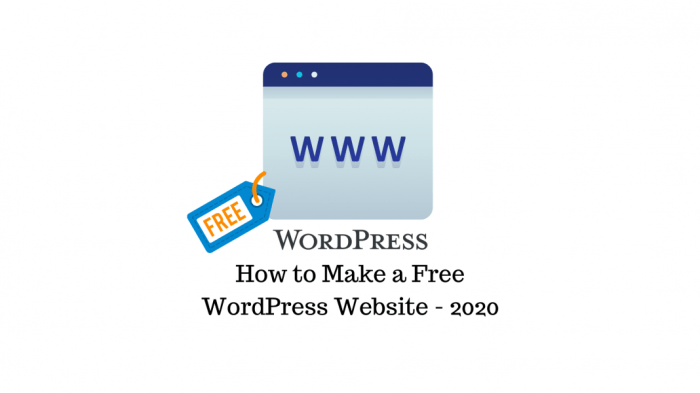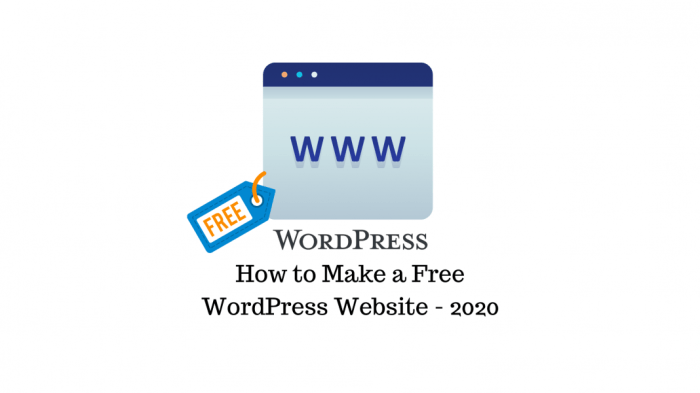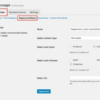How to try WordPress for free without a domain or hosting? This guide dives deep into various methods for experiencing WordPress’s power without the commitment of purchasing a domain and hosting. From free trials to temporary installations, and demo sites to local setups, we’ll explore the different approaches and their limitations. Whether you’re a beginner or an experienced user, understanding the options is crucial for making informed decisions.
We’ll cover everything from the basics of free trials and platform options to setting up a local environment and using demo sites. Each method will be analyzed for its features, limitations, and overall suitability for your needs. Get ready to unlock the world of WordPress without breaking the bank!
Introduction to Free WordPress Trials
Trying WordPress without committing to a domain and hosting is a great way to explore its features and functionality. Many resources offer temporary installations and demo sites to experience the platform. This approach lets you evaluate the platform before making any financial commitments. This exploration is especially beneficial for those considering WordPress as a blogging platform or website builder.
Different Approaches for Free Trials
There are several ways to experience WordPress without purchasing hosting or a domain. Free trials, temporary installations, and demo sites are common methods. Each approach has its own set of limitations and features.
Free Trials
Free trials are often offered by hosting providers or WordPress-related services. These trials typically grant access to a basic WordPress installation for a limited time, allowing users to experiment with themes, plugins, and other features. These trials are useful for getting a sense of the WordPress environment, but usually come with restrictions on resources and features.
Temporary Installations
Many websites offer temporary WordPress installations. These installations are often provided for a short duration, allowing users to create and test their website designs. While providing a hands-on experience, temporary installations often lack the flexibility of a full WordPress installation and may have limitations on the plugins and themes available.
Demo Sites
Demo sites are pre-built WordPress sites designed to showcase specific features and capabilities. These sites are excellent for quickly seeing how a WordPress website can be built, offering a quick look at the possibilities. However, demo sites typically are static and may not fully reflect the customizability of a personal WordPress installation.
Trying WordPress for free without a domain or hosting is surprisingly easy! You can use a free WordPress hosting provider like WordPress.com to get started. Knowing how to get your website seen by potential customers is key to success, and that’s where strategies like help customers find you come in. This will help you attract the right people and establish a strong online presence, even without a paid domain, which will help you build your WordPress site without spending a dime.
Comparison of Free Trial Methods
| Method | Duration | Features | Limitations |
|---|---|---|---|
| Free Trials (Hosting Providers) | Typically a few days to a week | Basic WordPress installation, limited resources, sometimes limited themes and plugins | Short duration, often restricted functionality, may not reflect full platform potential |
| Temporary Installations (Websites) | Usually a few hours to a few days | Hands-on experience, ability to test various functionalities | Limited duration, restrictions on themes and plugins, no long-term use |
| Demo Sites (Websites) | Indefinite, but static | Showcase specific features, visual representation of WordPress sites | No customizability, limited functionality, static nature |
Free WordPress Platforms and Services: How To Try WordPress For Free Without A Domain Or Hosting

Trying WordPress without upfront costs is a great way to learn and experiment. Many platforms offer free WordPress installations or trials, allowing you to experience the platform’s capabilities without the commitment of a paid domain or hosting plan. This approach is ideal for beginners, developers, or anyone looking to test the waters before investing in a full setup.These free platforms often have limitations, but they provide a valuable learning experience and a stepping stone towards a professional WordPress site.
Knowing the features and limitations of each platform is key to choosing the right one for your needs.
Free WordPress Installation Platforms
A growing number of platforms offer free WordPress installations, allowing you to create a site without purchasing hosting or a domain name. These options are generally well-suited for personal blogs, small portfolios, or testing purposes. This flexibility is particularly helpful for beginners.
- WordPress.com offers several free plans. While they include a subdomain (e.g., yourblog.wordpress.com), these plans are suitable for simple sites. They offer a straightforward installation process and a user-friendly interface. A significant advantage is the built-in support and maintenance that WordPress.com provides, taking care of essential server and security tasks for you.
- SiteGround’s free WordPress hosting provides a more robust platform for those who want more control. It is an excellent choice for those familiar with WordPress. The ease of use is comparable to WordPress.com, but with slightly more flexibility in terms of customization and functionalities.
- Bluehost’s free WordPress hosting offers a similar experience to SiteGround’s free plan. It allows users to set up a WordPress site without paying for hosting. The process is straightforward, and users can quickly start building their sites. It’s a good option for those looking for a simple yet reliable hosting solution. However, this is not always the most advanced option in terms of control and customization.
Comparison of Free WordPress Platforms
| Platform | Features | Limitations | User Reviews |
|---|---|---|---|
| WordPress.com | Easy setup, built-in support, good for beginners, various themes and plugins. | Limited customization options, subdomain required, limited storage space, ads may be displayed. | Generally positive, with users appreciating the ease of use and support. Some users mention the limitations as a drawback. |
| SiteGround Free Hosting | More control over the site, good for those familiar with WordPress, slightly more flexibility than WordPress.com. | Limited resources, may experience slower loading times compared to paid hosting, potential for less technical support. | Positive reviews often highlight the simplicity of setup and the relatively quick loading times for basic sites. Some users report occasional issues. |
| Bluehost Free Hosting | Straightforward setup, good for beginners, comparable to SiteGround in ease of use. | Limited resources, similar limitations to SiteGround in terms of speed and support, potentially fewer advanced features. | Positive user reviews emphasize the simplicity of the platform and the ease of getting started with a WordPress site. |
Setting Up a Local WordPress Environment
Trying WordPress without a domain or hosting is fantastic for testing and learning. A local environment allows you to experiment with themes, plugins, and functionality without affecting a live website. This method also helps you understand how WordPress interacts with your computer’s files and resources.A local WordPress environment is essentially a miniature version of a live website running on your computer.
Want to dip your toes into WordPress without shelling out for a domain or hosting? It’s totally doable! Free platforms like WordPress.com offer a fantastic way to get started. But once you’ve got your site up and running, you need to focus on which of your pages should I SEO optimize to get the most out of your efforts.
Considering the importance of SEO, you need to prioritize the pages that will attract the most relevant traffic. This will help you determine which pages will yield the best results. Check out this guide for more insights on which of my pages should I SEO optimize and then return to exploring those free options!
This provides a safe and controlled space for learning and experimenting with WordPress without worrying about affecting your online presence.
Software and Tools Required
To set up a local WordPress environment, you’ll need a few key tools. These tools help manage and run the local server and create a functional WordPress environment. The most crucial software is a local web server, like XAMPP or WAMP. These packages often include the necessary components for a fully functional WordPress installation. Additional tools, like a code editor (e.g., VS Code, Sublime Text) and a file explorer, are essential for managing files and customizing your installation.
Installing and Configuring XAMPP, How to try wordpress for free without a domain or hosting
XAMPP, a popular choice, bundles Apache (web server), MySQL (database), PHP, and Perl. Installing XAMPP involves downloading the appropriate installer for your operating system (Windows, macOS, or Linux). Follow the on-screen instructions to install the software. After installation, you should start the Apache and MySQL services. This establishes a functional server on your computer, ready to host your WordPress site.
Setting Up a WordPress Database
Once XAMPP is running, you need to create a database for your WordPress installation. Open your MySQL administration panel (often accessed through XAMPP’s control panel). Create a new database and a user with appropriate privileges to access that database. This user is crucial for WordPress to interact with the database. Note the database name, username, and password—you’ll need these later in the installation process.
Downloading and Extracting WordPress Files
Download the latest WordPress installation files from the official WordPress website. Extract the compressed files into a designated folder on your computer, typically within the web server’s document root directory (e.g., htdocs in XAMPP). This step involves unpacking the WordPress installation package and placing the necessary files in a location accessible to the web server.
Configuring WordPress
After extracting the WordPress files, access your local WordPress installation through your web browser by typing the appropriate URL. Follow the WordPress installation wizard. Enter the database name, username, password, and table prefix. This step configures the database connection for your WordPress installation. You should then choose a username and password for your WordPress admin account.
This step creates an administrator account, allowing you to log in and manage your local site.
Accessing and Testing Functionality
After successfully completing the setup, log in to your WordPress dashboard. Explore different sections, create posts, and test plugins to ensure everything is working as expected. This step confirms that the local WordPress installation functions correctly. The functionality should mimic a standard WordPress installation.
Free WordPress Demo Sites and Templates
Free WordPress demo sites and templates offer a fantastic way to experience the platform’s features without the hassle of setting up your own website. They allow you to explore different themes, plugins, and functionalities, getting a feel for how WordPress works in a real-world context. This is particularly valuable for beginners or those seeking to familiarize themselves with the platform’s versatility before committing to a full installation.Demo sites often come pre-populated with content, enabling you to quickly assess the look and feel of various designs and functionalities.
This hands-on approach proves invaluable for making informed decisions about your future website design and functionality.
Exploring Free Demo Sites
Free demo sites provide a realistic preview of what your WordPress website could look like. By exploring these demo sites, you can evaluate the functionality and design of different themes and plugins without needing to install them on your own server. This saves valuable time and resources, letting you quickly identify suitable choices for your project.
Finding Free Demo Sites and Templates
A wealth of resources offer free WordPress demo sites and templates. These resources are often updated with fresh designs, ensuring you have access to the latest options.
- WordPress.org Theme Directory: This directory is a fantastic starting point. Many themes offer demo sites showcasing their features and designs. Explore the various categories to discover templates that match your desired style and functionality.
- ThemeForest and similar marketplaces: While many offer premium themes, some providers offer free demo sites or trial versions of their templates. These can be invaluable resources for discovering new and creative designs.
- Free WordPress theme repositories: Several websites specialize in curating free WordPress themes. These sites often provide comprehensive documentation and detailed information about the available themes, making it easier to choose the right one for your needs.
- Individual developer websites: Developers sometimes provide demo sites for their themes or plugins on their own websites, enabling you to see their creations in action.
Evaluating Demo Sites and Templates
A crucial aspect of using demo sites is understanding their limitations and features.
| Demo Site | Template | Features | Limitations |
|---|---|---|---|
| Demo Site 1 (ThemeForest) | Modern Business | Responsive design, e-commerce integration, various layouts | Limited customization options, no support for all plugin integrations |
| Demo Site 2 (WordPress.org) | Minimalist Blog | Clean design, simple navigation, optimization | Basic functionalities, limited design variations |
| Demo Site 3 (Free theme repository) | Portfolio Showcase | Excellent visual appeal, portfolio-centric layouts, social media integration | May lack specific features, such as custom forms or advanced analytics |
These demos allow you to evaluate the site’s appearance, navigation, and key features. By understanding the limitations of each template, you can avoid surprises later.
Limitations and Considerations

Free WordPress trials, while offering a valuable way to experience the platform, come with inherent limitations. Understanding these limitations is crucial before committing to a project, especially for businesses or individuals with significant needs. Choosing the right level of service often involves balancing the advantages of free access with the restrictions it imposes.Free trials frequently sacrifice features, performance, and support to make the service accessible.
Weighing these trade-offs is important when considering whether the free version aligns with your project’s requirements. Free options are excellent for exploration and testing, but for established projects or those with specific needs, a paid subscription is often necessary.
Restricted Features and Functionality
Free WordPress trials often have limitations on features and functionality. These restrictions can vary greatly depending on the specific platform or service provider. Limited storage space, restricted plugin availability, and bandwidth caps are common. For instance, a free trial might only allow a certain number of posts or pages, limiting the scope of your project. These constraints might affect the development and expansion of your website, especially if you anticipate growing content or traffic.
Trade-offs Between Free and Paid Services
Free WordPress trials offer a glimpse into the platform, allowing exploration without financial commitment. However, they frequently come with limitations. Paid services, on the other hand, typically provide comprehensive features, robust support, and greater flexibility. This trade-off means that free trials are suitable for testing and prototyping, while paid services are more suitable for established projects and businesses requiring greater functionality and support.
Trying WordPress for free without a domain or hosting is surprisingly easy. Many free platforms offer temporary installations, perfect for testing themes and plugins. However, consider the costs involved when using features like Google Maps; if you’re planning to incorporate interactive maps, be mindful of potential charges from services like google mapping and api charging.
Once you’ve got a grasp of those potential costs, you can confidently proceed with your free WordPress trial.
A good example is the limited customization options available in free trials compared to the comprehensive design tools in paid subscriptions.
Implications for Business and Personal Projects
Using free WordPress trials for business or personal projects requires careful consideration. For small-scale personal blogs or portfolios, free trials might be sufficient. However, for businesses with complex needs, like e-commerce websites or sophisticated online platforms, the limitations of free trials could prove detrimental. Businesses should carefully evaluate whether the functionality and support offered by a free trial adequately meet their specific requirements.
A free trial might be suitable for a personal portfolio, but a business website demanding significant features like advanced security and customer management would likely require a paid subscription.
Importance of Backups and Security
Free WordPress platforms may have limitations on backup and security features. Regular backups are crucial for preventing data loss from unforeseen events. Security vulnerabilities are also a concern, and free platforms might not offer the same level of protection as paid services. This means it’s critical to implement additional security measures to protect your website from attacks.
Using strong passwords, enabling two-factor authentication, and regularly updating your software are crucial, regardless of whether the platform is free or paid. Free trials might not include automated backup systems or proactive security monitoring. A business or personal website with valuable data should prioritize implementing robust backup and security measures, regardless of the platform used.
Alternatives to Free WordPress Trials
Sometimes, a full-fledged free trial isn’t the best option for testing WordPress. You might want a quicker, more focused approach to understanding its functionality before committing to a paid setup. This section explores alternatives, like using free subdomains and sandbox environments, and compares them to traditional trials.While free trials offer a comprehensive look at the platform, they often come with limitations.
Alternatives offer a more targeted approach for specific tasks, like setting up a basic website or experiencing specific features. They are ideal for evaluating if WordPress fits your needs before making a larger investment.
Free Subdomain Alternatives
Using a free subdomain with a hosting provider is a popular alternative for evaluating WordPress without a full-fledged trial. This method provides a real-world, albeit limited, experience of running a WordPress site.
- Flexibility and Control: Free subdomains usually allow you to install and configure WordPress plugins and themes. You can test out various configurations and understand how they affect the site’s performance and appearance. This is crucial for understanding WordPress’s flexibility and how different elements interact.
- Real-World Experience: Unlike demo sites, a free subdomain provides a genuine, albeit restricted, online experience. You can see how your site behaves under real-world conditions, though you’ll need to be mindful of the limitations of a free subdomain.
- Cost-Effectiveness: Free subdomains are a budget-friendly approach, saving you from the expense of a paid hosting trial. This is especially beneficial for beginners or individuals on a tight budget.
Setting Up a Free Subdomain
This section provides a practical guide for using a free subdomain to test WordPress.
- Choose a Hosting Provider: Numerous hosting providers offer free subdomains. Research and select a reputable provider with a good track record for reliability and customer support. Look for features like easy installation and good documentation.
- Create a Subdomain: Follow the hosting provider’s instructions to create a subdomain. This typically involves navigating through their control panel and creating a new subdomain. Usually, a new user account may be needed.
- Install WordPress: The hosting provider usually provides clear instructions on how to install WordPress on your new subdomain. This typically involves using their one-click installer.
- Configure and Test: Once WordPress is installed, you can configure it and test its functionalities. Experiment with themes, plugins, and other features to gain hands-on experience. Be mindful of the limited resources associated with free subdomains.
Comparison of Alternatives
| Feature | Free WordPress Trial | Free Subdomain | Sandbox Environment |
|---|---|---|---|
| Cost | Usually free, but may have limitations | Free | Free (often part of a paid service) |
| Functionality | Comprehensive | Limited by resources | Controlled environment, potentially limited |
| Real-World Experience | Limited | Yes, but with restrictions | No, often used for development |
| Setup Complexity | Generally simple | Usually simple | Can be complex, depending on the setup |
| Control | Limited in trial period | More control, but resource-constrained | High level of control |
Conclusion (Avoid)
Exploring free WordPress trials, platforms, and local environments opens up a world of possibilities for website creation without upfront costs. Understanding the limitations and available alternatives is crucial for making informed decisions about your project. This exploration equips you with the knowledge to select the best approach for your specific needs and goals.Free WordPress options, while attractive for their accessibility, often come with trade-offs.
A crucial aspect of navigating these choices is recognizing the potential limitations of each approach. This understanding is key to avoiding frustration and ensuring a successful website launch, regardless of your budget or technical expertise.
Evaluating Free WordPress Options
A comprehensive assessment of free WordPress trials, platforms, and local environments requires a careful analysis of features, functionalities, and limitations. This process helps users make informed choices. A key element of this assessment is the understanding of the various trade-offs associated with each option.
- Feature Set Limitations: Free platforms often have restricted features compared to paid versions. This can range from limited storage space to restricted design customization options. These limitations can be significant, especially for ambitious projects needing extensive functionalities.
- Technical Support: Free services usually offer minimal or no dedicated technical support. This can be a major drawback when encountering technical issues during setup or maintenance. Users may need to rely on online forums or tutorials for assistance.
- Scalability Concerns: Free WordPress trials and platforms often have limitations on scalability. As your website grows, you might encounter issues handling increased traffic or data volumes. Free plans often don’t accommodate significant traffic growth. Users should consider whether the free option can support anticipated traffic levels.
Choosing the Right Approach
The ideal approach for a free WordPress website depends heavily on individual needs and expectations. Understanding the specific constraints of each method is vital to making an informed decision. Consider factors like project scope, anticipated traffic, and technical proficiency.
- Local Setup: A local environment is a great option for developers who want complete control over their website’s configuration. However, it requires technical expertise and ongoing maintenance. This method provides significant flexibility for advanced users, but necessitates a deeper understanding of website technology.
- Free Demo Sites/Templates: Free demo sites and templates offer a quick way to visualize a website’s appearance without significant setup. These options are suitable for simple websites with limited features, but their flexibility is often restricted. They can be ideal for creating basic portfolios or personal blogs.
- Free WordPress Hosting Providers: Some hosting providers offer free WordPress hosting with limitations. This option is suitable for users who want a hosted environment but are restricted by budget. This can be a suitable starting point for users wanting a hosted platform but with budget restrictions. Free hosting providers often include ads or limited bandwidth.
Alternatives for Enhanced Functionality
If the limitations of free WordPress options prove restrictive, several alternatives offer more comprehensive features. Understanding these alternatives is crucial for future scalability.
- Paid WordPress Hosting: Paid hosting solutions provide more resources, including increased storage space, faster loading speeds, and enhanced security features. These solutions provide a reliable foundation for larger and more complex projects.
- Managed WordPress Hosting: Managed WordPress hosting services handle the technical maintenance of your website, freeing up your time for other tasks. These services are particularly beneficial for users with limited technical skills. They can handle upgrades and security updates, allowing users to focus on content creation.
- Other Website Builders: Alternatives to WordPress, like Squarespace or Wix, offer user-friendly interfaces and pre-built templates. These platforms are suitable for users who prioritize ease of use and minimal technical expertise. However, they may offer less customization compared to WordPress.
End of Discussion
In conclusion, trying WordPress for free without a domain or hosting is achievable through several methods. While free trials offer a taste of the platform, they often come with limitations. Understanding these limitations and the trade-offs between free and paid services is essential for successful project development. Whether you choose a free platform, a local setup, or demo site, this guide equips you with the knowledge to make the best decision for your needs.
Happy WordPressing!






